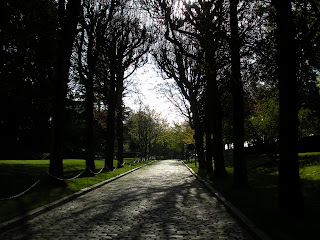I know some people are squeamish about scenes of animal death but I am fascinated by them. I have spent many a fine evening enraptured by the documentaries of Sir David Attenborough with his matter-of-fact voice, “here is a majestic wildebeest…being eaten by a lion.” and “look at the playful meerkats…as a hyena snatches one away in its jaws of death.” The depiction of the miracle of life juxtaposed with sudden violence brings into sharp focus some of the starkest issues of our existence. Purpose, meaning, deity and mystery are always the subtext of death; and if it is animal violence we speak of then Darwin is sure to enter the discussion as well.
I came across a gruesome scene on my walk last Friday (warning: graphic pictures ahead—I will post them at the very bottom so you can easily avoid them if you so wish). On the path along the creek there was a large rat, neatly decapitated with the middle third of it’s body— neck, fore paws, and thorax—missing. The lower half of it’s body was left on the sidewalk, it’s still gurgling digestive track spilling out, with nearby head unblinkingly watching me.
It was hard to tell which animal had performed this fatal surgery but easy to rule out the innocent. It was too neat a job for cat, house or feral, and raptors tend to jab and tear at the flesh with beak and claw. The precision of the bite that cut the body in half was almost knife-like; it was clear that something had bit through the poor beast in a single chomp. It could have been a coyote which I did not even know existed in Oregon until several weeks ago when on a walk near sunset I heard a chorus of cub yips in the distance followed by the familiar howl. We have cougars here but it is hard to imagine a predator which typically goes after fawns, chickens and family pets bothering with something as small as a rat. Perhaps a small bobcat or it might have been a weasel; there is a family of them living in the meadow across the way. I once saw mom and her pups undulating in single file across the field in the low morning fog like some evolving sea serpent transitioning to land.
What was most curious to me was, which animal would have gone to all trouble to procure such a catch, to expend the energy necessary to track and kill this fine repast but then to abandon more than half of it here on the sidewalk? Perhaps some human happened upon the scene and scared it off mid-meal, though it seems more likely that the predator would have just carried off it’s prize to consume in safety elsewhere.
This circle-of-life-Simba scene quickly brought to mind the nature of vegetarianism. I understand the vegetarian arguments against eating meat. The moral reasons, the ecological reasons, the health reasons all make sense; but the sense of those arguments is diminished when viewed through the lens of the natural universe.
Writer Isaac Bashevis Singer proclaimed that, “even in the worm that crawls in the earth there glows a divine spark. When you slaughter a creature, you slaughter God.” Singer stopped at the worm in his journey down the food chain, but I’ll go a bit further. Think of the Jainists who sometimes wear veils so as to not inadvertently breathe in a midge or gnat to die ignominiously in the mucal goo of their sinuses. Is this compassion misplaced? Could we perhaps be doing more to alleviate human suffering rather than waste any of our short lives worrying about gnats? What about when you clean the toilet or vacuum the rug? In those acts we are killing millions of bacteria and bugs and dust mites. Are those life forms also not deserving of our respect?
In our home we have an arachnid relocation program wherein spiders are given new identities and transplanted to the great outdoors. But just as often as not, if it is pouring outside or the spider too hard to catch or looks to be poisonous, I will dispatch it quickly twixt Kleenex’d fingers whilst saying with faux sincerity (and, curiously, a British accent), “Oops, so sorry, better luck next life.” I often imagine that if there is a god, and it is not without a sense of humor, then no doubt the last words I will hear as I am squashed in the fingers of some Cockney giant will be, “oops, so sorry, better luck next life.”
The spider relocation program was instituted by my daughter, she of the species,
adolescent vegetarian. I understand the compassion behind her attitude but I also find it selective. When you ingest an antibiotic you are killing countless bacteria who would not give a second thought to whacking you (if indeed they have any thoughts at all). I’ve never heard a vegetarian or vegan speak compassionately of the bacteria and dust mites that we inadvertently slaughter by the millions each day just by dint of living. Our compassion for other species seems limited to the life forms we can see and preferably who embody some degree of cuteness (Ironically and amusingly, this adorable stuffed dust mite:

will soon be home to thousands of actual not-so-adorable dust mites shortly after you bring it into your home.)

In consideration of the dust mite, is it so far-fetched for a sentient mite to think of their host as some sort of god? As far as the mites know the being that supports them in the entirety of their life cycle gave rise to them as well. Perhaps they too have erected churches to you, their deity, and sing your praises as well before each meal of dead skin cells that have sloughed from your body. Maybe they also wonder if there are other life forms in other galaxies, trillions of
mite years away, in the next room.
And so perhaps the entity we think of as god is no more god to us than we are to the dust mite who inhabits our couch. Perhaps we are ascribing vast powers to this god only because we cannot conceive of its size and its nature but who surely must be aware of
our existence; just as we know of the dust mite who also cannot conceive of our size and nature. We would then be left with god having conjured us no more than we the mite; which makes our relationship with god entirely tangent and not a little weird, like a Facebook friend request from a dust mite.
When the galactic janitor finally makes his way into this dusty corner of the multiverse for a thorough housecleaning perhaps we will all be as dust mites to his solar system sized Dyson, with nary a sentient being to give us a second thought as we swirl into the oblivion of his vacuum. The most oft-asked question that fills the cultural chasm of this human world is, “Do you believe in god?” I propose that this may be the wrong question and frequently wonder if the right question is, “Does god believe in us, and if so, is it in the same manner that we believe in dust mites?”
Only the galactic janitor knows for sure and perhaps the dispatched rat I found on the sidewalk knows something about it too.
























































